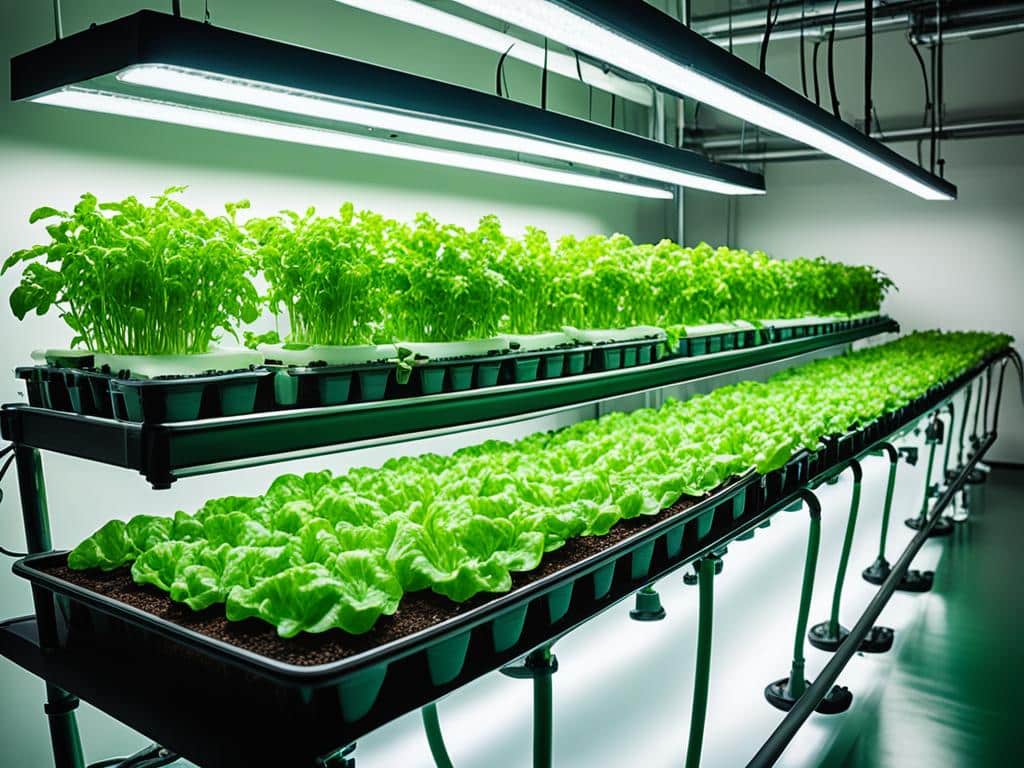If you’re intrigued by the idea of how to grow hydroponic vegetables at home, you’re not alone. This soil-less farming method has become a game-changer for enthusiasts looking to dive into cultivating hydroponic vegetables within the comfort of their own space. Whether it’s the allure of year-round indoor gardening or the commitment to sustainable farming techniques, hydroponics offers an innovative way to produce fresh, nutritious produce regardless of the season.
With a few essentials and a bit of guidance, you can start your very own hydroponic garden. It’s a fulfilling endeavor that not only yields a bounty of fresh greens but also contributes positively to the environment. Let’s delve into the basics and pave the way for your hydroponic adventure.
Key Takeaways
- Get to know the essentials of setting up a home hydroponic garden.
- Discover the benefits of cultivating hydroponic vegetables for both health and environment.
- Learn about the advantages of creating a sustainable year-round indoor garden.
- Understand how hydroponics fits into modern sustainable farming techniques.
- Gain insight into the simple steps to begin your journey in growing hydroponic vegetables at home.
Understanding the Basics of Hydroponics
The world of hydroponic gardening is one that combines technology with nature to create a vibrant, soilless ecosystem for plants. This innovative approach to cultivation is rooted in precise hydroponic gardening principles, offering multiple advantages of hydroponics over traditional farming methods.
What is Hydroponics?
At its core, hydroponics is a method of growing plants without soil, using nutrient-rich water solutions to provide the vital minerals and elements required for growth. This soilless farming method presents an efficient, sustainable, and adaptable alternative to conventional agriculture, making it possible to cultivate plants in places where soil conditions are less than ideal.
The Science Behind Hydroponic Gardening
The scientific mechanisms that power hydroponics have revolutionized the way we think about plant growth. Unlike soil, which can be unpredictable and variable, a hydroponic system gives the grower complete control over the environment. Plants are supplied with a perfectly balanced pH and nutrient mix, which can be adjusted to suit the specific needs of each plant species.
Benefits of Growing Hydroponic Vegetables
Apart from the satisfaction of seeing your vegetables thrive, there are substantial health and environmental benefits of growing hydroponic vegetables. These systems use considerably less water than traditional farming, reduce the need for pesticides, and enable year-round production in controlled environments. Below is an overview comparing hydroponics with traditional soil farming:
| Aspect | Hydroponics | Soil Farming |
|---|---|---|
| Water Efficiency | Up to 90% more efficient | Lower efficiency due to evaporation and runoff |
| Nutrient Control | Precise control over nutrient balance | Dependent on soil quality and conditions |
| Space Required | Less space due to vertical stacking options | Requires more area for the same yield |
| Yield | Higher yields possible with optimized environments | Yields are subject to environmental factors |
| Pesticide Use | Reduced need for pesticides | Often requires pesticides to control pests and diseases |
The Best Hydroponic Systems for Beginners
Embarking on the journey of hydroponic gardening can seem daunting at first, but with the right setup, beginners can experience the joys of soilless cultivation with ease. Here we explore three of the most user-friendly hydroponic setups, perfect for those new to this growing method. Each system offers a different approach to hydroponics and can be customized or expanded as your confidence and experience grow.
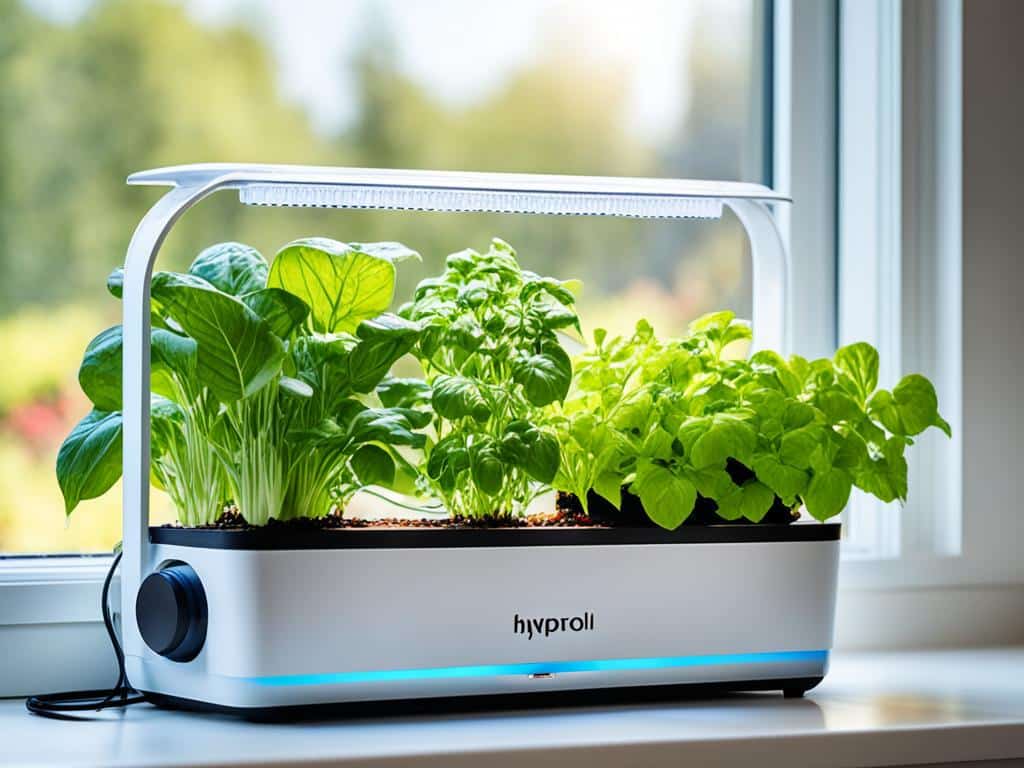
Wick Systems
For enthusiasts looking for DIY hydroponic systems, the wick system stands out due to its simplicity and low maintenance. It is ideal for those who prefer a passive hydroponic setup with minimal moving parts. The wick system utilizes capillary action to draw nutrient-rich water from a reservoir to the plants’ roots using a simple wick, making it a foolproof choice for new growers.
Deep Water Culture (DWC)
Deep Water Culture (DWC) is a favorite among easy hydroponic setups due to its straightforward design and effectiveness. The plants’ roots are suspended in a nutrient solution, providing constant access to water, nutrients, and oxygen. This beginner hydroponic solution is perfect for those who want to see rapid plant growth and don’t mind a little more setup up front.
Nutrient Film Technique (NFT)
Another great beginner hydroponic solution is the Nutrient Film Technique, or NFT. This system involves a continuous flow of nutrient solution over the roots of plants, which are housed in channels. Since the flow of water is recirculated, it’s an efficient use of resources. However, it’s slightly more technical than wick or DWC systems but no less suitable for beginners.
Choosing the right system involves balancing your desired level of involvement with the specific needs of your plants. DIY hydroponic systems allow for a customized approach, making it easy to adapt your setup as you gain more insight into the intricacies of hydroponic gardening. These easy-to-implement options provide the opportunity to master the art of hydroponics and enjoy a bountiful harvest.
How to Grow Hydroponic Vegetables
Embarking on the soilless vegetable cultivation journey with hydroponics not only opens a gateway to sustainable farming but also ensures efficient production of nutritious vegetables. By implementing efficient hydroponic techniques, cultivators can maximize yield with minimal environmental impact. Below are essential aspects to consider when diving into the world of hydroponic vegetables growing methods.
Choose the Right System: Various hydroponic systems are available, each with unique benefits. From the beginner-friendly Deep Water Culture (DWC) to the more advanced Nutrient Film Technique (NFT), selecting a system aligns with your growing goals and space limitations.
Quality Nutrient Solutions: A balanced nutrient mix is critical for the robust growth of hydroponic vegetables. Customized solutions catered to specific plant needs not only provide essential minerals but also bolster plant immunity against pathogens.
Controlled Environment: By managing factors such as lighting, temperature, and humidity, growers can create an ideal microclimate that accelerates vegetable growth, irrespective of external weather conditions.
Referencing “Growing Up: The Vertical Farming Revolution,” we learn that vertical farming with hydroponics not only saves considerable space but also allows for higher yields through efficient hydroponic techniques. Meanwhile, “The Efficient Garden” highlights the importance of strategic plant spacing and pruning to optimize air circulation and light penetration, ensuring that each plant receives the attention it needs.
Moreover, the use of automation in hydroponic systems can substantially reduce labor while also refining the precision of watering and nutrient delivery. Integration of timers, sensors, and software assures that the vegetables receive optimum care on schedule, making the hydroponic process more manageable and less time-consuming.
To succinctly capture this, an overview of recommended practices are outlined below:
- Selection of hydroponic systems based on space efficiency and ease of maintenance.
- Formulation and administration of nutrient solutions tailored to various growth stages.
- Regular monitoring and adjustment of environmental controls to sustain growth.
Add these hydroponic fundamentals to your gardening playbook and watch your hydroponic vegetables thrive in a dynamic, soil-free landscape.
Choosing the Right Plants for Your Hydroponic Garden
When it comes to hydroponic gardening, not all plants are created equal. To ensure success, it’s important to select crops that are well-suited to the conditions of your hydroponic system. Focusing on optimal hydroponic crops can lead to a more bountiful and rewarding harvest. Let’s delve into some of the best plants for hydroponics that should top your hydroponic gardening selections.
Leafy Greens and Salad Varieties
Leafy greens are a staple in the hydroponic world due to their quick growth and minimal space requirements. Plants like lettuce, spinach, and kale thrive in hydroponic systems, contributing to a consistent supply of fresh salad greens. Their adaptability to various hydroponic methods makes them ideal for both beginners and seasoned gardeners.
Herbs
Herbs are another group of plants that flourish in hydroponic setups. Basil, cilantro, and mint, detailed in “Herbs on Water: A Guide to Hydroponic Herb Gardening,” are popular choices. They not only grow efficiently but also add flavor to meals and can be harvested repeatedly, providing an ongoing yield for your culinary creations.
Fruiting Plants
A more challenging yet rewarding category for hydroponic farming includes fruiting plants. Varieties such as tomatoes, cucumbers, and peppers are suitable for more advanced hydroponic systems, as mentioned in “The Fruiting Challenge: Hydroponic Methods.” These plants tend to require additional support and careful nutrient management, but the results can be extraordinarily gratifying.
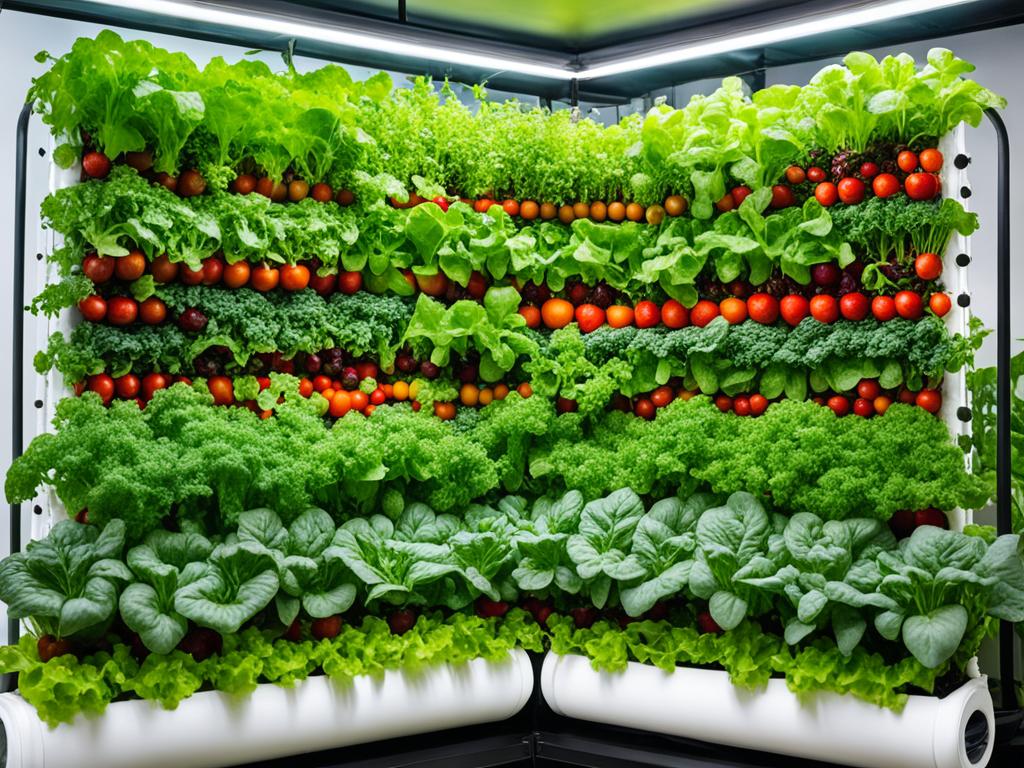
The table below offers a glance at some of the most recommended plants for hydroponic gardening:
| Plant Type | Optimal Hydroponic System | Growth Difficulty | Yield Expectation |
|---|---|---|---|
| Lettuce | Deep Water Culture (DWC) | Easy | High |
| Spinach | Nutrient Film Technique (NFT) | Easy | High |
| Basil | Ebb and Flow | Easy | High |
| Tomatoes | Drip System | Moderate | High |
| Cucumbers | Drip System | Moderate | High |
| Peppers | Aeroponic | Challenging | Moderate-High |
Selecting the right crops is just the beginning of your hydroponic gardening journey. Each plant type offers unique benefits and requires special attention. By choosing those that are known to perform well in hydroponic settings, gardeners can maximize their yields and enjoy the fruits of their labor throughout the year.
Creating the Perfect Hydroponic Environment
Unlocking the full potential of a hydroponic garden requires meticulous hydroponic environmental control to simulate the ideal growing conditions for your plants. Achieving this involves a system of balance among light, temperature, and humidity – all key components that influence plant health and productivity. Let’s delve into how setting up hydroponic lighting and maintaining an optimal climate for hydroponics can drastically enhance your garden’s yield.
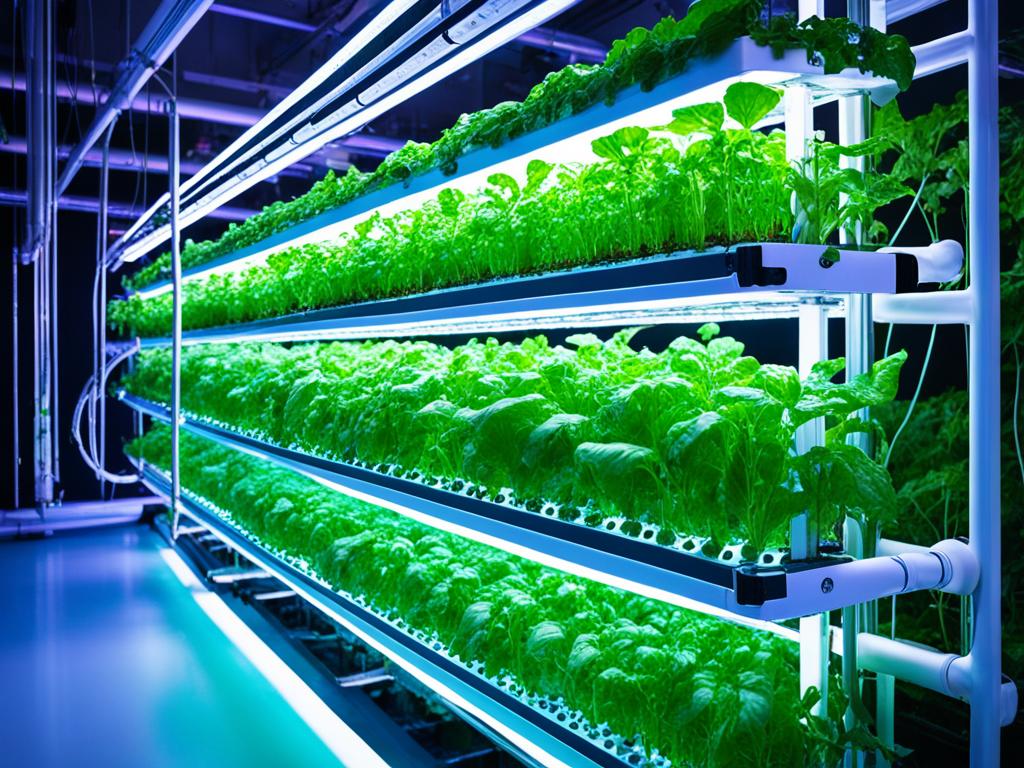
Lighting Requirements for Hydroponic Plants
Appropriate lighting is crucial for plant photosynthesis and overall growth. In hydroponics, where nature’s light cycle is not always readily available, setting up hydroponic lighting that mimics the spectrum and intensity of sunlight can spell the difference between a thriving garden and one that struggles. Concepts from “Let There Be Light: Hydroponic Lighting Solutions” recommend various lighting options such as LED, High-Intensity Discharge (HID), and fluorescent lights. Each of these provides different benefits depending on your plants’ specific needs. For example:
- LEDs provide full-spectrum light, are energy-efficient, and have a long lifespan.
- HID lamps, including Metal Halide and High-Pressure Sodium lights, offer intense illumination suitable for larger setups.
- Fluorescent lights, like T5s, are ideal for seed starting and young plants due to their softer light output.
Temperature and Humidity Control
Maintaining a consistent and optimal climate for hydroponics involves careful control of temperature and humidity. The source “The Controlled Environment: Managing Temperature and Humidity in Hydroponics” shares that temperatures ideally should hover between 65-80°F (18-26°C), as extreme temperatures can negatively impact plant metabolism and nutrient uptake.
Humidity, on the other hand, should be managed to avoid conditions that could harbor mold or stress plants. Aim for a humidity level around 40-60%, adjusting your environmental control systems to add or remove moisture as needed. Here are practical strategies for managing both:
| Environmental Factor | Recommended Range | Control Strategies |
|---|---|---|
| Temperature | 65-80°F (18-26°C) | Use of heaters or coolers, proper insulation, and ventilation systems |
| Humidity | 40-60% | Employment of dehumidifiers or humidifiers, utilizing circulation fans |
With a clear understanding of your plants’ requirements and the tools mentioned, you’ll be equipped to create and sustain an environment that will maximize your hydroponic garden’s productivity. Remember, consistent monitoring and adjustment are essential for hydroponic environmental control to ensure your garden remains a cut above the rest.
Nutrient Solutions and pH Levels
Embarking on the intricate journey of hydroponic gardening means ensuring that your plants have the nutrients they require for optimal growth. A bespoke hydroponic nutrients mix tailored for different plant types is essential for a bountiful harvest. Moreover, adjusting pH for hydroponics plays a pivotal role in nutrient uptake, making it a critical aspect of perfecting hydroponic nutrients. Drawing wisdom from the comprehensive guide, “Nutrient Recipes for Hydroponic Success,” allows growers to formulate targeted solutions that deliver all the necessary elements plants crave.
Mixing Your Nutrient Solution
Creating an effective hydroponic nutrients mix requires a blend of science and precision. The primary goal is to mimic the mineral content of the best soil, ensuring that plants receive an ample spectrum of essential nutrients. Macro elements such as nitrogen, phosphorus, and potassium (N-P-K), along with microelements like calcium, magnesium, and iron, must be present in the correct ratios. Here’s a basic framework for a nutrient mix suitable for a wide range of plants:
| Nutrient | Role | Recommended PPM (parts per million) |
|---|---|---|
| Nitrogen (N) | Vital for leaf growth | 200-250 |
| Phosphorus (P) | Root development and energy transfer | 40-60 |
| Potassium (K) | Overall plant functions and disease resistance | 200-300 |
| Calcium (Ca) | Cell wall strength and growth regulation | 170-200 |
| Magnesium (Mg) | Chlorophyll production and seed formation | 40-50 |
| Iron (Fe) | Essential for chlorophyll synthesis | 2-2.5 |
By fine-tuning this recipe based on specific plant needs and growth stages, you can optimize the contribution of each element to promote vigorous growth and abundant yields.
Maintaining Ideal pH Levels
Once you have the nutrient solution mixed, it’s imperative to address the surrounding pH level. The resource “pH Mastery: The Hydroponic Gardener’s Guide” highlights that the ideal pH range generally falls between 5.5 and 6.5 for most hydroponic crops. This range allows plants to access the nutrients in the solution most efficiently. Regularly adjusting pH for hydroponics is hence a key practice, and it can be done using pH-up or pH-down solutions. Learning to measure and adjust pH with precision is part of perfecting hydroponic nutrients, which directly correlates to the health of your plants:
- Use a reliable digital pH meter for consistent monitoring.
- Add pH adjusters in small increments to avoid fluctuations.
- Track and chart pH levels to anticipate future adjustments.
Through diligent care and the right balance of nutrients and pH, your hydroponic system will nourish plants from seedling to harvest, leading to lush growth and high-quality produce.
Maintaining Your Hydroponic Vegetable Garden
The success of a hydroponic garden is heavily predicated on consistent upkeep. Effective hydroponic garden upkeep is not just about keeping the system running; it’s about ensuring your plants receive the right attention to flourish. Caring for hydroponic vegetables involves regular monitoring and adjustment according to precise hydroponic maintenance routines. By establishing a consistent care schedule, you can preemptively tackle issues and maintain vibrant, healthy plants.
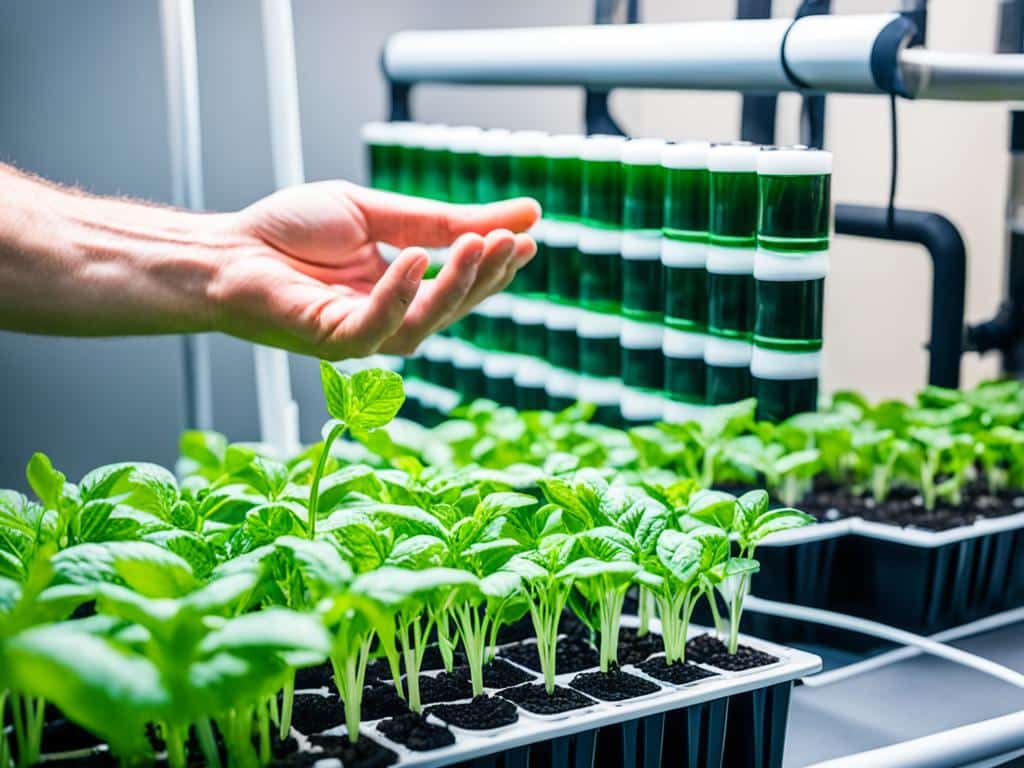
Consulting sources like “Routine Care for Your Hydroponic Garden,” gardeners can divide the hydroponic maintenance routines into daily, weekly, and monthly tasks:
- Daily: Check system pumps and pipes for proper function, monitor water levels, and observe plant health.
- Weekly: Test nutrient solution and make adjustments, trim and prune plants, and inspect for pests or disease.
- Monthly: Clean or replace filters, replenish or refresh nutrient solutions, and deeply clean reservoirs.
“Trouble-Free Hydroponics” provides gardeners with a wealth of solutions to common problems. From nutritional deficiencies to unexpected system failures, the key is to remain vigilant and informed:
Prevention is as crucial as the cure. Regular checks for discoloration, stunted growth, or signs of pests can save crops from larger issues down the line.
Table demonstrates a succinct hydroponic maintenance schedule that can act as a guideline for any hydroponic gardener looking to optimize their garden’s productivity and longevity.
| Maintenance Task | Frequency | Action Points |
|---|---|---|
| System Check | Daily | Ensure all mechanical components are working seamlessly. |
| Water and Nutrient Levels | Weekly | Adjust the solution’s concentration and replenish water. |
| Plant Health Inspection | Weekly | Look for signs of stress, pests, or disease in plants. |
| Filter Maintenance | Monthly | Clean to prevent clogs and ensure efficient system operation. |
Hydroponic garden upkeep doesn’t need to be overwhelming. By embedding regular care into your routine, caring for hydroponic vegetables becomes a rhythmic part of the gardening experience, ensuring your plants stay healthy and your harvest bountiful.
How to Grow Hydroponic Vegetables Indoors
Delving into indoor hydroponic farming may seem complex, but with an understanding of space-efficient hydroponics and the essential hydroponic gear, you can transform any corner of your home into a verdant haven. “The Indoor Eden: Setting Up Your Hydroponic Garden” sheds light on creating a productive space no matter the square footage. By exploiting vertical space and implementing compact system designs, even the smallest of indoor areas can yield impressive crops.
Space Considerations and Setup
According to experts, the right setup is critical in indoor hydroponic farming. A strategic approach involves assessing your available space and selecting a hydroponic system that fits your environment. Vertical farming, one of the most space-efficient hydroponics methods, allows you to grow upwards rather than outwards, increasing yield per square foot. With the right type of system, such as wall-mounted or stacking units, you can maximize production in limited spaces without sacrificing quality.
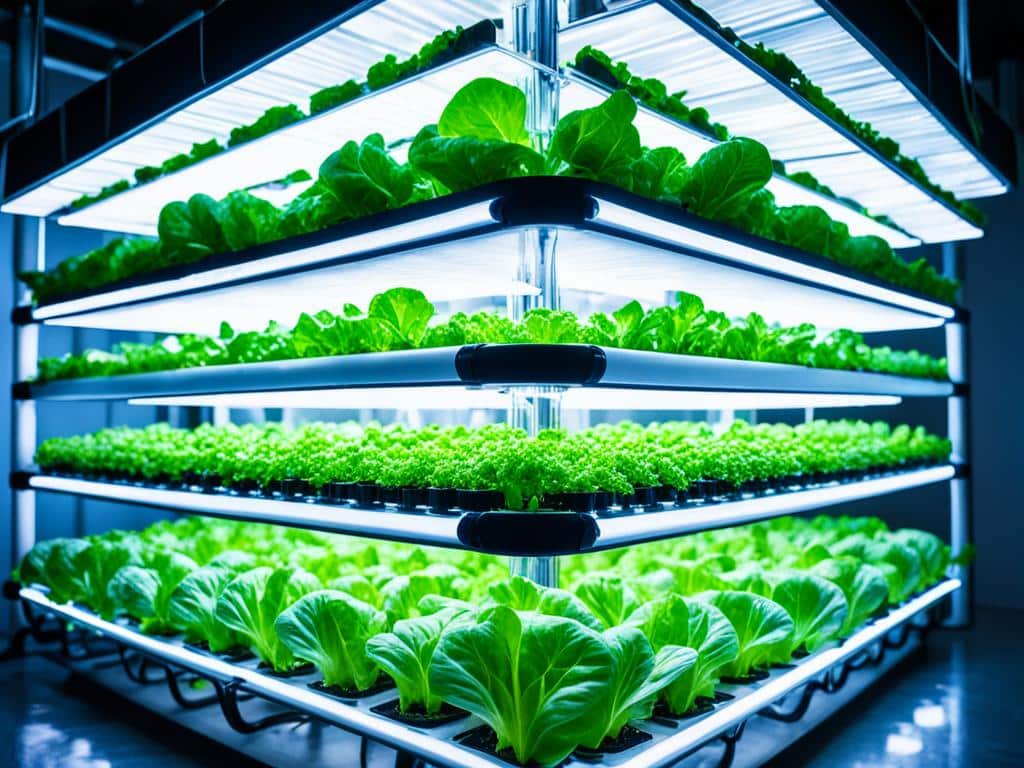
Notable systems suitable for indoor hydroponics, especially in confined spaces, include:
- Stackable hydroponic towers
- Wall-mounted planters with integral hydroponic features
- Modular hydroponic shelves
Each system offers its unique advantage, balancing the spatial dynamics with the specific growth requirements of your chosen hydroponic vegetables.
Additional Equipment for Indoor Hydroponics
“Gearing Up: Tools for Indoor Hydroponic Farmers” enumerates the essential hydroponic gear needed to ensure your indoor garden thrives. Beyond the fundamental hydroponic system, you’ll need equipment that addresses lighting, climate control, and monitoring:
| Equipment Type | Function | Benefits |
|---|---|---|
| LED Grow Lights | Provide full-spectrum light for photosynthesis | Energy-efficient, low heat output, and customizable to plant needs |
| Climate Control Systems | Manage temperature and humidity levels | Creates stable growing conditions, reducing stress on plants |
| pH and EC Monitors | Monitor nutrient and pH levels of the solution | Ensures optimal nutrient uptake and prevents deficiency/toxicity |
| Automated Watering Systems | Consistent and precise delivery of nutrients | Saves time, reduces waste, and maintains consistency in feeding |
| Air Pumps and Stones | Oxygenate the nutrient solution | Promotes root health and prevents anaerobic conditions |
Equipped with these specialized tools, nurturing an indoor hydroponic garden becomes a smooth and manageable process, paving the way for a thriving green space within your home.
Harvesting Your Hydroponic Vegetables
Reaping the fruits of your labor—harvesting hydroponic produce—is both an art and a critical phase in the cycle of sustainable farming. “Picking the Future: Harvesting in Hydroponics” sheds light on when to harvest each type of vegetable for maximum flavor and nutrition. Understanding the nuanced timing and adopting the right hydroponic vegetables picking techniques can significantly influence the quality of your harvest.
When and How to Harvest
The key to a successful harvest lies in recognizing the signs of peak maturity. For example, lettuce should be harvested when the leaves are tender and fully developed but before they reach the stage of bolting. Tomatoes, on the other hand, should be picked when they showcase a uniform color and yield to slight pressure. “Picking the Future” recommends using clean, sharp scissors or knives to cut the vegetables, ensuring minimal damage to the plant and avoiding the spread of disease.
Timing is everything—harvesting in the morning ensures that the plants have the highest water content, resulting in crispier leafy greens. Proper technique is also crucial—such as cutting at the stem’s base for leafy greens. Also, twisting fruits like tomatoes off the vine gently encourages continued fruiting.
Monitoring growth patterns and setting harvest schedules are core components of hydroponic gardening that consistently yield premium-quality produce. The care invested into picking hydrates your trust in the sustainability and self-sufficiency of hydroponic methods.
Post-Harvest Handling and Storage
According to “From Water to Table: Storing Hydroponic Harvests,” the aftercare of your vegetables decides their shelf life and their journey from harvest to consumption. Immediate cooling and proper storage of hydroponic crops are imperative for preserving freshness and extending their utility.
Here are some best practices for post-harvest handling:
- Wash vegetables gently to remove any nutrient solution residue before storage.
- Pre-cool vegetables to remove field heat which can accelerate spoilage.
- Store in a dark, cool place with adequate humidity controls to prevent wilting and loss of texture.
Different vegetables have varying storage needs. Here’s a table that summarizes optimal storage conditions for some common hydroponic vegetables:
| Vegetable | Storage Temperature | Relative Humidity | Estimated Shelf Life |
|---|---|---|---|
| Lettuce | 32°F (0°C) | 95%-100% | 2-3 weeks |
| Tomatoes | 50-70°F (10-21°C) | 85%-90% | 1-2 weeks |
| Cucumbers | 50°F (10°C) | 95% | Up to 1 week |
| Basil | 55°F (13°C) | 95%-100% | 4-7 days |
| Bell Peppers | 45-55°F (7-13°C) | 95% | 2-3 weeks |
Maintaining the integrity of your hydroponic harvest depends greatly on these post-harvest processes. By faithfully following storage guidelines, your hydroponic vegetables can retain their just-picked taste far longer, making your sustainable efforts all the more rewarding.
Troubleshooting Common Hydroponic Issues
Even the most carefully managed hydroponic systems can encounter challenges. Coping with hydroponic problems timely and efficiently can make a significant difference in the health of your plants and the productivity of your garden. In this section, we’ll cover some common issues faced by hydroponic gardeners, focusing on hydroponic pests management and maintaining nutrient balance in hydroponics.
Dealing with Pests and Diseases
Pest control in hydroponics requires vigilant monitoring and proactive strategies due to the absence of soil’s natural biological defenses. Integrated pest management (IPM) is a sustainable approach to hydroponic pests management that utilizes a combination of biological, cultural, physical, and chemical methods to control pest populations. Some effective IPM strategies include:
- Maintaining a clean and sterile environment to prevent infestations.
- Introducing beneficial insects, like ladybugs, that prey on harmful pests.
- Applying organic insecticidal soaps or neem oil as a last resort.
Remember, prevention is key: consistent sanitation and regular inspection of your hydroponic system will help you manage these issues before they escalate.
Nutrient Deficiencies and Toxicities
Ensuring nutrient balance in hydroponics is a delicate art that involves recognizing the signs of deficiencies or toxicities and rectifying them. “Nutrient Solutions: Deficiency and Toxicity” outlines how to identify and correct nutrient imbalances that can hinder plant growth. Common signs of imbalance include:
- Deficiencies: Yellowing leaves, stunted growth, and fruit discoloration.
- Toxicities: Burnt leaf tips, reduced flowering, and leaf cupping.
To address these issues, it’s crucial to regularly test and adjust the strength and pH of your nutrient solution. The table below provides a guidance on acceptable pH and nutrient ranges for a hydroponic garden:
| Nutrient Element | Deficiency Symptoms | Toxicity Symptoms | Optimal Range (PPM) |
|---|---|---|---|
| Nitrogen (N) | Yellowing of older leaves | Darker foliage, delayed flowering | 200-250 |
| Phosphorus (P) | Dark, bluish-green leaves | Stunted growth, affected roots | 40-60 |
| Potassium (K) | Brown spots and curling leaves | Salt buildup, leaf tip burn | 200-300 |
| Calcium (Ca) | Blossom end rot in fruits | Deposition on root system | 170-200 |
| Magnesium (Mg) | Interveinal chlorosis in leaves | Leaf margin curling and yellowing | 40-50 |
| Iron (Fe) | Young leaves turn yellow | Bronzing and tiny leaves | 2-2.5 |
Understanding and adjusting your nutrient solutions appropriately is essential for maintaining a thriving hydroponic system. With careful monitoring and intervention, you can prevent the majority of nutrient-related issues, ensuring the robust growth and high yields of your hydroponic vegetables.
Conclusion
As we journey through the enriching world of hydroponics, it’s evident that embracing hydroponic gardening extends beyond merely producing vegetables; it is about adopting a lifestyle that prioritizes sustainability and community involvement. From the novice gardener to the advanced practitioner, sustainable hydroponic practices pave the way toward a more self-sufficient and environmentally-conscious way of living. By integrating these practices into our routines, we become part of a growing hydroponic gardening community that values food security, health, and the well-being of our planet.
Embracing the Hydroponic Lifestyle
“The Hydroponic Way of Life” emphasizes the transformative experience hydroponic gardening offers. It’s a practice that requires dedication, ingenuity, and a willingness to engage with nature in an unconventional yet profoundly rewarding manner. As individuals weave hydroponics into their daily lives, they cultivate more than vegetables; they grow a sense of fulfillment and participation in a movement towards sustainable hydroponic practices. Moreover, the support and shared knowledge within the community further enrich this lifestyle, inspiring continued growth and innovation.
Continuing Your Hydroponic Education
Hydroponic gardening is a field ripe with opportunities for continuous learning and mastery. “Beyond the Basics: Continuing Hydroponic Education” serves as a guide for those eager to deepen their knowledge and refine their skills. Whether it’s through community workshops, online forums, or specialized publications, resources are plentiful for those seeking to learn advanced hydroponic techniques. The path of learning is unending, and as technology evolves, so do the methods and possibilities within the hydroponic space, ensuring that gardeners at any level can find new ways to enhance their craft and the quality of their harvest.

